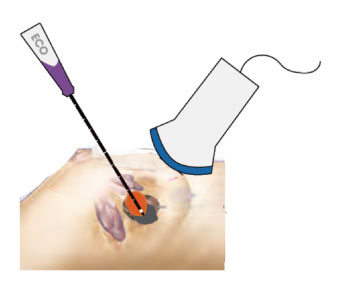ECO Microwave Ablation Minimally Invasive Treatment for Breast Tumors
Incidence rate of benign breast tumors
Benign breast tumor is a common breast disease, more common in young women, the probability of developing into a malignant tumor is very small. However, benign tumors grow slowly, especially during pregnancy. Due to the changes of hormones in the body, a small number of benign tumors will grow rapidly or even become malignant. During the period of suffering from benign tumors, regular examinations are needed to monitor the growth of tumors.
Fibroadenomas is the most common benign tumor of breast, may cause change of shape and anxiety. Possibility of malignant transformation.
Local resection
Resection will be complete, but as with all surgical procedures, breast lump removal can carry some risks, including: infection, pain, swelling, scar tissue, change in appearance of the breast.
Vacuum assisted breast circumcision
Minimally invasive operation, scar is about 2mm, but the tissue damage inside the breast is not small, and for patients with multiple or larger nodules,repeated circumcision increases the risk of bleeding.
Thermal ablation MWA, RFA, Laser
Minimally invasive, less pain, shorter operation time, won’t affect appearance and function of mammary gland.
Principle of Microwave Ablation
Microwave ablation is a new type of minimally invasive treatment, which is carried out under real-time monitoring of ultrasound equipment. It uses an ablation antenna with a diameter of only 2mm to penetrate into the tumor through percutaneous approach. It can kill the tumor cells by generating high temperature inside the tumor, which can avoid the resection of the lesion tissue.
Indications - Benign Breast Nodules
- Tumor size smaller than 3cm in greatest diameter confirmed by using US and CEUS;
- Distance between nodule and the skin and ectopectoralisz 0.5 cm;
- Nodule should not be located in the nipple areola area;
- Patient requests for the treatment and has beauty needs.
Indications - Breast Fibroadenoma
B-RADS grade 3 or conventional ultrasound BI-RADS grade 4A and contrast-enhanced ultrasound or breast
MRI result indicates grade 3; for patients over 35 y/o, BI-RADS grade 3 or below;
The tumour smaller than 3cm in greatest diameter confirmed by using US and contrast-enhanced us (CEUS); • Fibroadenoma confirmed by core needle biopsy;
For multiple tumors, breast MRI evaluation can be considered, and the following conditions must be met:
- (1) Longest diameter measured by ultrasound and contrast-enhanced ultrasound is 1-3 cm;
- (2) Distance between tumor and skin/ectopectoralis > 0.5 cm;
Comparison of different treatment methods
Low frequency radio-waves
Stable treatment temperature
Only monitored by MRI
Limited usage for tumor subtypes
Low success ratio
High-frequency
Real noninvasive treatment
Less dissipation of heat
Tiny ablate target
Longer treatment time
HIFU
Application scope is limited, focus area is small, needs to be repeated for many times More effective for smaller lesions with thinner abdominal wall and less blood supply Operation is time-consuming
Cryo-ablation
- Ice ball could be seen under MRI
- Not good for larger size tumors (>2cm)
- Several freeze-thaw cycles during treatment
- Cryo-expense
Advantages of microwave ablation for Breast Tumor
Simple procedure, short operation time;
More safe and effective;
Minimally invasive “patient friendly”procedure,
Fast recovery with very short hospital stay:
Less complications;
Achieves cosmetic effect.

